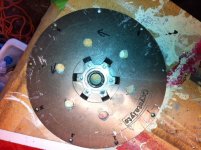John in CR
100 TW
For the perimeter holes I like to use a multiple of the number of bolt holes, so none of the exhaust vent holes get too close to the bolt holes. I also place them as close to the perimeter as physically possible without cutting into the inside edge of the retaining lip.
Go ahead and write inside the cover, which is which for left and right, and think the angles through several times before actually drilling. A center punch to make a divot so the drill bit doesn't walk when starting the hole is a huge help.
Here's my latest covers with one side intake and other side exhaust in an effort to get more air through the 50mm magnetic gap, but I'm undecided on whether the reduced total flow is worth it. Note that the blades are bolted and epoxied with some surface prep of both the blades I cut from AL sheet and the cast AL cover. With bolts I never have to worry about one coming off and ruining the motor, and the epoxy means a blade could never start rattling. I think the intake side needs another ring or 2 of 12mm holes, but that's the wire side and I'm not reharnessing the motor to drill more holes until I'm sure the ventilation is choked off at the intake. I debated about 5 blades or 15, and decided to start with just 5. I can easily add 10 more to the exhaust side, since that cover is easy to remove.

Go ahead and write inside the cover, which is which for left and right, and think the angles through several times before actually drilling. A center punch to make a divot so the drill bit doesn't walk when starting the hole is a huge help.
Here's my latest covers with one side intake and other side exhaust in an effort to get more air through the 50mm magnetic gap, but I'm undecided on whether the reduced total flow is worth it. Note that the blades are bolted and epoxied with some surface prep of both the blades I cut from AL sheet and the cast AL cover. With bolts I never have to worry about one coming off and ruining the motor, and the epoxy means a blade could never start rattling. I think the intake side needs another ring or 2 of 12mm holes, but that's the wire side and I'm not reharnessing the motor to drill more holes until I'm sure the ventilation is choked off at the intake. I debated about 5 blades or 15, and decided to start with just 5. I can easily add 10 more to the exhaust side, since that cover is easy to remove.













